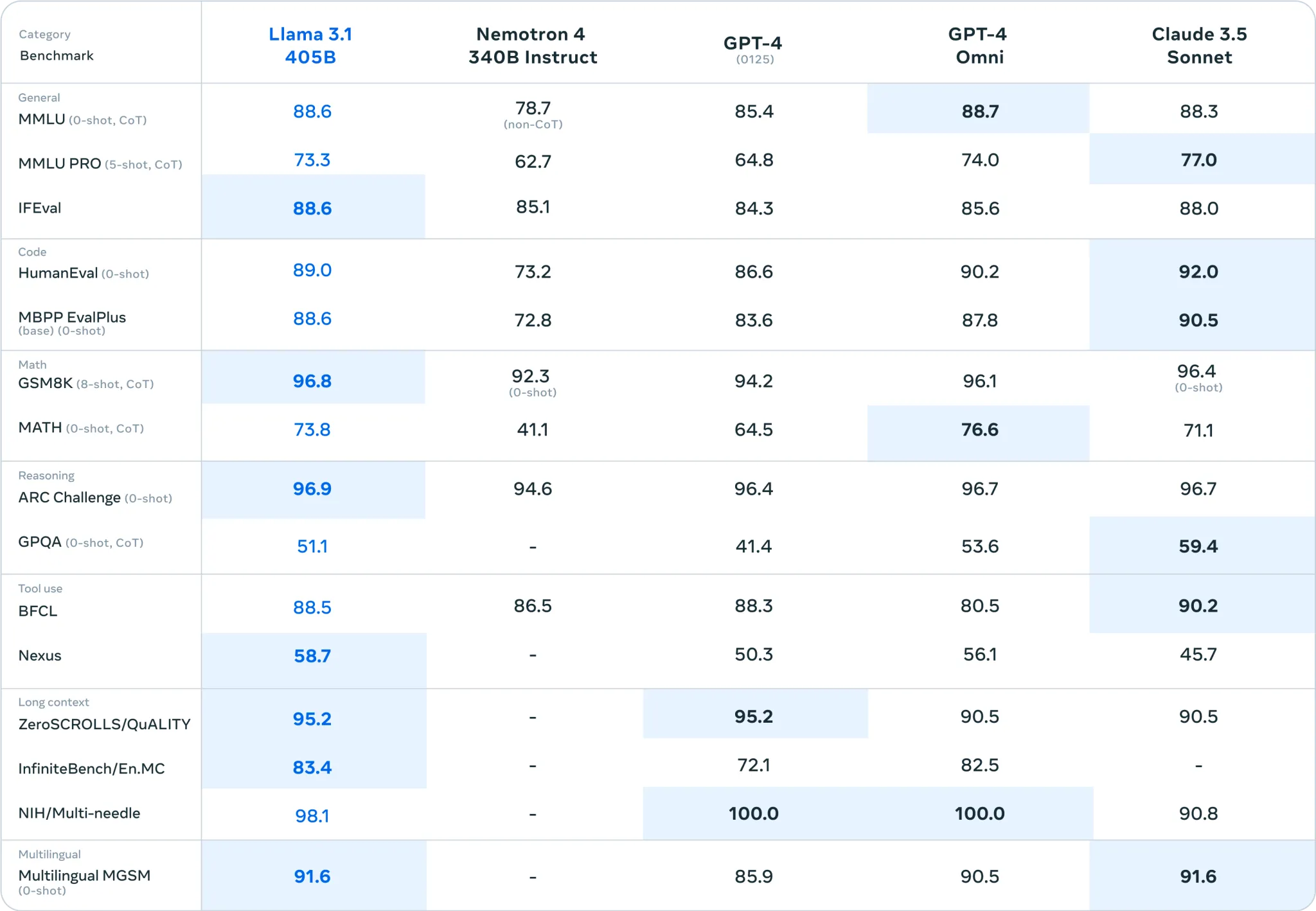Meta Launches Its Most Capable Model: Llama 3.1
Llama 3.1
Meta has unveiled its latest AI model, Llama 3.1, featuring 405 billion parameters. This model sets a new standard in AI technology, aiming to compete with top-tier models like GPT-4 and Claude 3.5 Sonnet. This release is particularly relevant for Chief Information Officers (CIOs), Chief Technology Officers (CTOs), VPs/Directors of IT, Marketing, and Sales, as well as Data Scientists, Analysts, and AI/ML Engineers.
Unprecedented Versatility
Llama 3.1 handles a wide range of tasks, including image, video, and speech processing, making it a versatile tool across various applications. Marketing teams can create more engaging content, while IT departments can enhance security measures through advanced image processing. The model's ability to manage multiple modalities ensures that businesses can streamline operations and innovate in diverse fields.

Credits: Meta
Multilingual Proficiency
Supporting eight languages—English, German, French, Italian, Portuguese, Hindi, Spanish, and Thai—Llama 3.1 offers a significant advantage for global companies. Its 128k token context window allows for more comprehensive and nuanced interactions, enhancing customer service and support. This multilingual capability helps businesses expand their reach and improve communication with international clients.
Open Source Accessibility
Meta’s commitment to open source with Llama 3.1 encourages innovation and research. By making both pre-trained and post-trained versions available to the public, Meta empowers developers to create custom solutions tailored to specific needs. This open-source model allows for extensive customization, making it an invaluable asset for data scientists and AI/ML engineers.
Enhanced Safety and Reliability
Llama 3.1 introduces Llama Guard 3, enhancing input and output safety, and ensuring reliability for real-world applications. This feature is crucial for sectors like healthcare and finance, where data privacy and security are paramount. By integrating these safety measures, businesses can confidently deploy the model in sensitive environments.
Superior Performance in Complex Tasks
Llama 3.1 excels in tasks requiring deep understanding and accuracy, such as coding, math, and complex reasoning. IT and software development teams can benefit from its ability to automate coding tasks and solve complex problems efficiently. The model’s advanced reasoning capabilities support data analysis and strategic decision-making processes.
Practical Business Applications
Llama 3.1 can be integrated into various business processes, including customer service chatbots and research assistants. For marketing departments, AI-powered chatbots can enhance customer engagement and support. Sales teams can leverage the model for data-driven insights, improving lead generation and conversion rates.
Cloud Integration
Available on major cloud platforms such as AWS, Azure, Google Cloud, and WhatsApp, Llama 3.1 offers flexible deployment options. This ensures that companies can integrate the model into their existing infrastructure and operational workflows with ease. The broad ecosystem support makes it accessible for immediate development and implementation.
Meta's Commitment to Open AI
Meta's dedication to openly accessible AI is underscored by the extensive support for Llama 3.1. With over 25 partners, including AWS, NVIDIA, Databricks, and Dell, offering services from day one, the ecosystem is robust and ready for innovation. Mark Zuckerberg’s letter on the benefits of open source highlights Meta’s vision of fostering a collaborative and inclusive AI development community.
Llama System and Ecosystem
Meta is developing Llama as a comprehensive system, providing components and reference systems to help developers create custom agents and new types of agentic behaviors. The introduction of tools like Llama Guard 3 and Prompt Guard ensures responsible AI development. The Llama Stack API, a standard interface, facilitates easier integration and interoperability across third-party projects.
Model Architecture and Training
Training Llama 3.1 on over 15 trillion tokens involved significant optimizations, utilizing over 16,000 H100 GPUs. The model uses a standard decoder-only transformer architecture with iterative post-training procedures, enhancing its capabilities. These advancements result in a model that is competitive with leading foundation models across a range of tasks.
Practical Applications and Case Studies
Meta's open-source approach has already led to innovative applications, such as an AI study buddy in WhatsApp, an LLM for clinical decision-making, and a healthcare startup in Brazil organizing patient information. These examples demonstrate the real-world impact and potential of Llama 3.1 in various industries.
Performance Benchmarking
To provide a comprehensive understanding of Llama 3.1's capabilities, here are some key performance benchmarks:

As shown in the performance comparison, Llama 3.1 outperforms other models in several categories, demonstrating its superior capability in general knowledge, code evaluation, math, reasoning, tool use, long context processing, and multilingual tasks.
Conclusion
Llama 3.1 represents a significant leap in AI technology, offering unmatched versatility, multilingual proficiency, and enhanced safety features. For CIOs, CTOs, IT, Marketing, and Sales leaders, as well as Data Scientists and AI/ML Engineers, this model provides a powerful tool to drive innovation and efficiency.
To explore more about Llama 3.1:
- Visit Meta's official website.
- Experiment with the open-source model to understand its potential applications within your organization: https://ai.meta.com/blog/meta-llama-3-1/
- Engage with Meta's community forums to share experiences and gain insights from other users.
- Consider pilot projects to integrate Llama 3.1 into your existing systems and workflows.
Follow Us on Linkedin and stay ahead in the rapidly evolving field of AI and machine learning.
